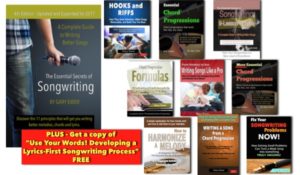 Thousands of songwriters are using “The Essential Secrets of Songwriting 10-eBook Bundle” to improve their songwriting technique. Become the most consistent songwriter you can be!
Thousands of songwriters are using “The Essential Secrets of Songwriting 10-eBook Bundle” to improve their songwriting technique. Become the most consistent songwriter you can be!
If you like melody-first songwriting processes, you know there are several ways to proceed. Here’s one method, for example:
- You coming up with a melody, or fragment(s) of melody.
- You find chords that work well and support the melody, and apply those chords using a particular rhythm and tempo.
- You get a sense of mood and meaning that emanates from that melody/chord combination.
- You create lyrics that support the mood and meaning of your melody.
This is a kind of long-winded way of saying: all elements of a song work together as musical partners. Nothing exists on its own within a song; how we perceive one element influences how we hear all of them.
I like the melody-first method of writing, because melodies are the parts of song that resonate most strongly with us, at least in most songwriting genres. We recall rhythms and chords, but mostly as vehicles for transporting those all-important melodies.
In the 3rd step above, I mentioned the sense of mood and meaning that comes from getting a melody and chord progression working together. How your melody moves — the up and down of it — can either enhance that mood or work against it. Here are some tips for making sure that the melodies you write support the mood and emotion that you hope your audiences pick up from it:
- Allow melodies to move higher when you want more emotion. (Think of the chorus of Nirvana’s “Smells Like Teen Spirit”)
- Ease your melodies down into the lower range when you’re being more narrative, pensive or introspective in style than overtly emotive. (Think of the verses of Tracy Chapman’s “Fast Car.“
- Let your melodies sit around one note when you want audiences to feel that you’re expressing strong opinions (think Dylan’s “Like a Rolling Stone”)
- Let your melodies leap upward when you want to draw attention to an especially emotionally-charged moment.
- Think about the key of your song, and the range in which that decision places your melody. Higher melodies create a tenseness in the voice that can help or hinder the musical meaning you hope your song is conveying.
 Written by Gary Ewer. Follow Gary on Twitter.
Written by Gary Ewer. Follow Gary on Twitter.
 Got a melody but can’t figure out how to add chords to it? You need to read “How to Harmonize a Melody.” Complete with sound samples to guide you. Get it separately, or as part of “The Essential Secrets of Songwriting 10-eBook Bundle”
Got a melody but can’t figure out how to add chords to it? You need to read “How to Harmonize a Melody.” Complete with sound samples to guide you. Get it separately, or as part of “The Essential Secrets of Songwriting 10-eBook Bundle”










